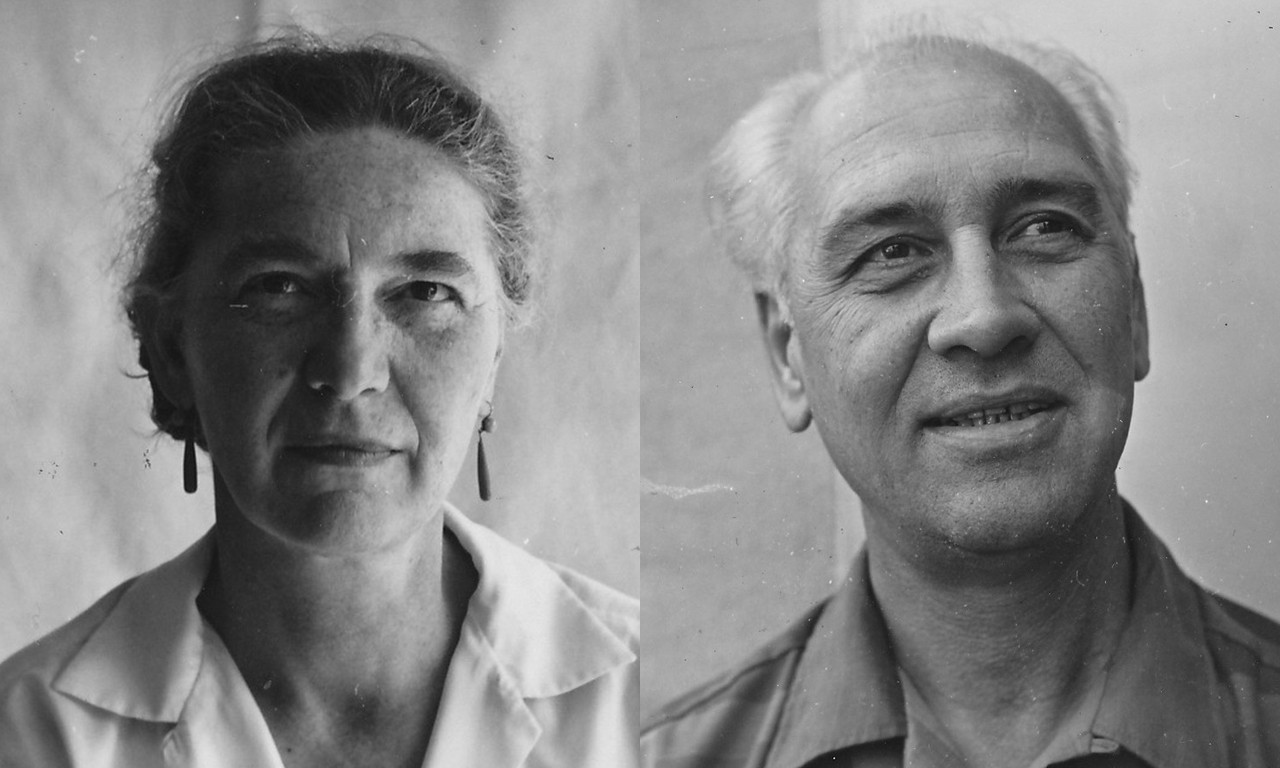 |
Carolyn and Dr. Douglas Osborne, 1968 passport photographs
Images courtesy of Frieda Wray |
Tolúk Back
In a previous blog post we showcased two rare tolúk currency pieces from the Osborne Collection which originates from the island country of Palau in southwest Micronesia. Though the post focused more on the objects than their provenance, the donation came from the daughter of Dr. Douglas Osborne and Carolyn Osborne, a husband and wife duo of American archaeologists. Beginning in the ‘50s, the Osborne couple began pioneering some of the earliest archaeological studies in the Micronesian area, specifically on the islands of Palau. This post begins a series on the family behind the Collection, their contributions to the field of archeology, and a brief look at some the other objects in the donation.
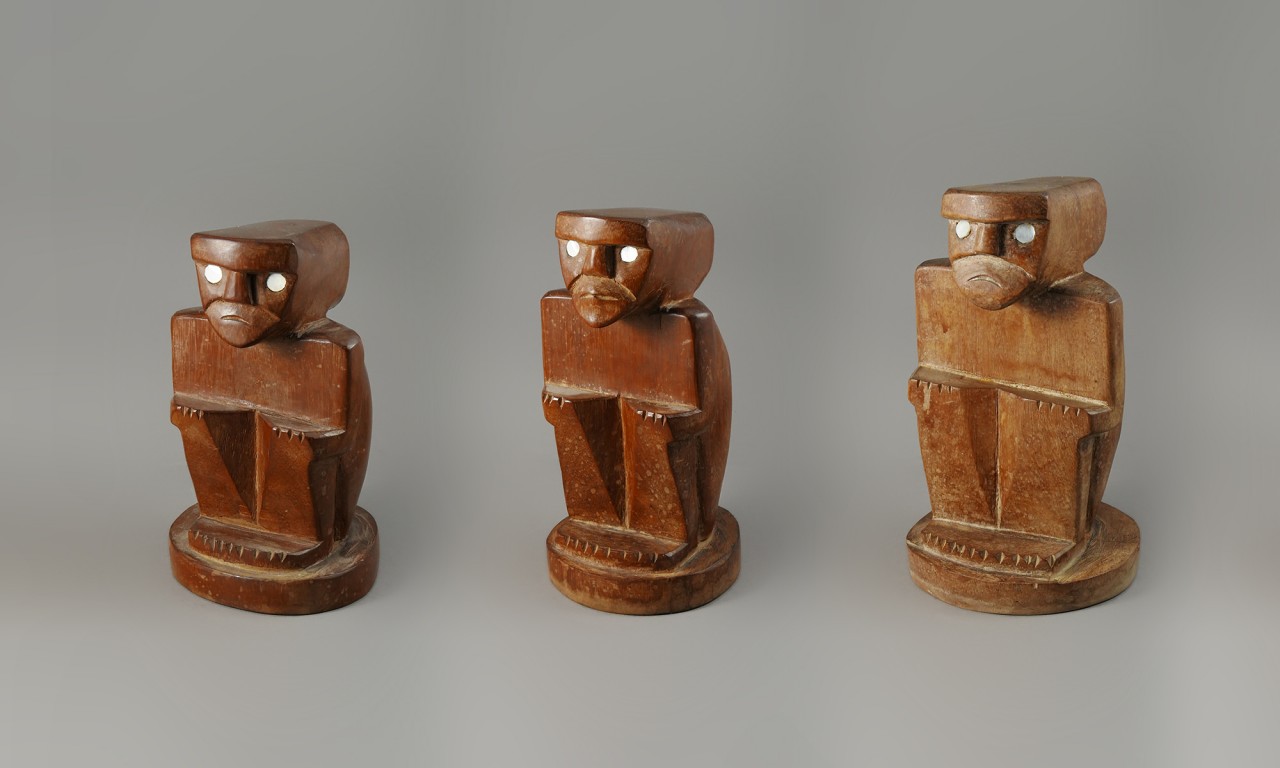 |
Monkey-Man Figures, mid 20th Century
Jimmy Mtoched (Palauan) and Unknown Artists; Koror Island, Palau, Micronesia
Wood and shell
2019.17.25-.27
Gift of Frieda O. Wray from the Estate of Dr. & Mrs. Douglas and Carolyn Osborne |
Homeric Odyssey
Dr. Homer Douglas Osborne (1912-1995) was an American archaeologist who conducted much of his field work with fellow archaeologist and wife Carolyn Mildred Osborne, née Miles (1919-2008). In 1940, they met as graduate students at the University of New Mexico and collaborated on an archeological scouting excursion in Michoacán, Mexico. They married the following year, shortly before the United States entered World War II. Due to his ongoing academic studies, Mr. Osborne was not immediately drafted into the war. Nonetheless, Mr. and Mrs. Osborne took part in their patriotic duties and enlisted in the United States Marine Corps. Carolyn was immediately shipped out to the Marine Corps Quantico Base to work as an analyst and Douglas spent some time in the California shipyards, prior to being dispatched to the newly liberated Guam in 1944 as a Military Policeman. There he was tasked with capturing remaining Japanese soldiers. More interested in archaeology than combat, Douglas Osborne “tromped through the boonies” with only vague approval from his Commanding Officer looking for remnants of the island’s earliest peoples. His discoveries awoke Osborne’s long-lasting fascination with Pacific archaeology.
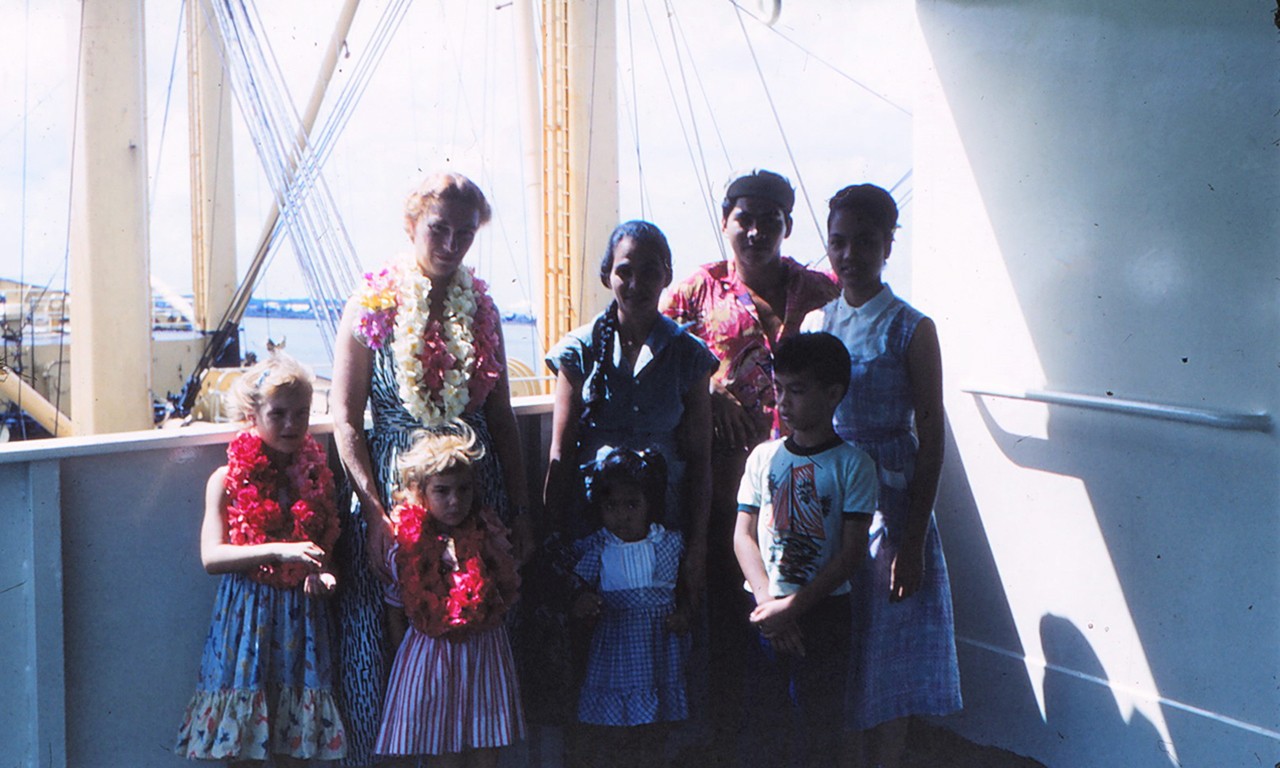 |
Carolyn, Frieda and Ellen and friends, 1954
Image courtesy of Frieda Wray |
Circumventing the Problem
Following the end of the war, Douglas and Carolyn Osborne reunited and continued their schooling and work in archaeology. In 1948, Mr. Osborne accepted a position as acting field director for the Smithsonian Institution in the River Basin Surveys Program in Umatilla, Oregon. To encourage her husband, Carolyn ended her graduate work and assisted in the program by analyzing perishables, photographing materials and editing her husband’s reports. Over the remainder of their professional careers they continued this arrangement on numerous excavations all over the world. Douglas would excavate and collect much of the data onsite and Carolyn would document and photograph their findings. At the time academic papers written by women were regularly not published by major journals on the basis of gender alone, as such Mrs. Osborne was simply credited as Dr. Osborne's assistant on numerous projects, despite having significantly contributed to findings. Carolyn Osborne sidestepped some of this discrimination by focusing on an area of concentration that most male archeologists often ignored: textiles. The Osborne duo continued their joint partnership—both in marriage and career—and contributed pivotal works that expanded the archaeological community over the course of their lives.
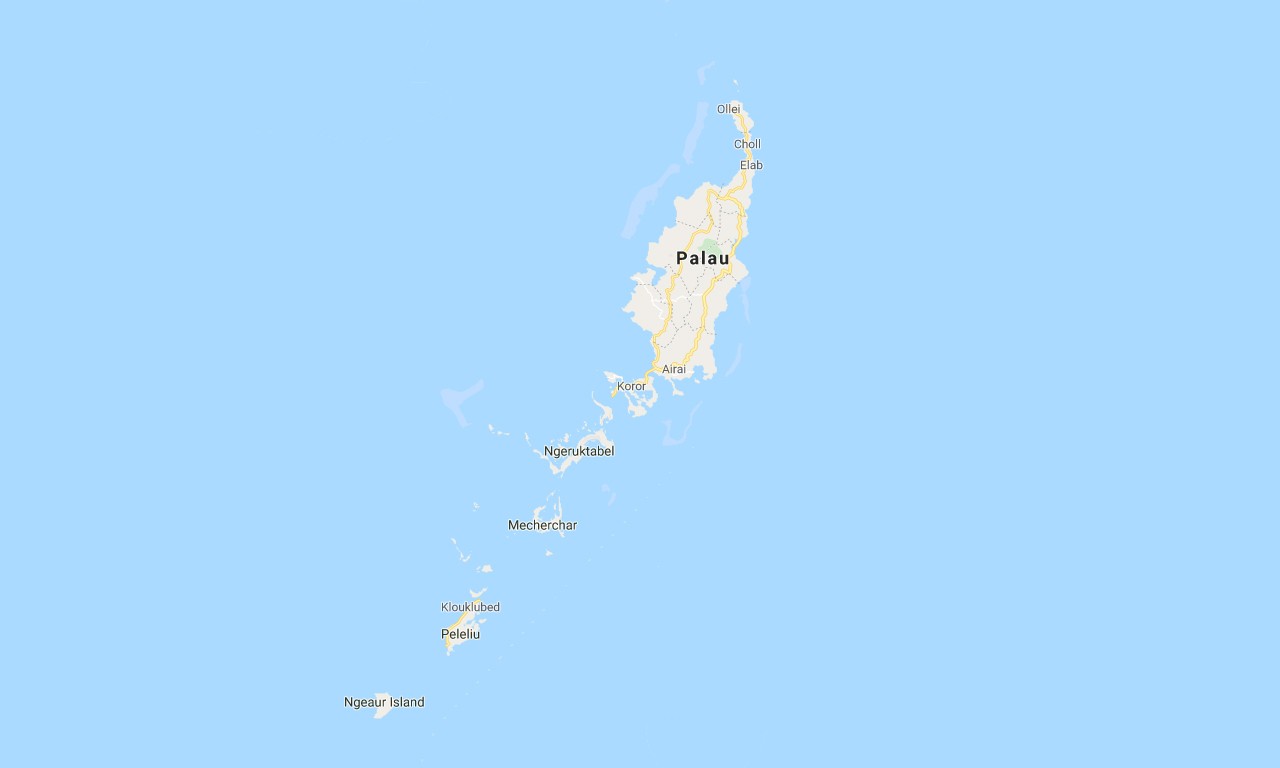 |
| The islands of Palau, courtesy of Google Maps |
Dr. Osborne, I Presume
After obtaining his doctoral degree and securing a faculty position at the University of Washington, Dr. Osborne began to ponder his time in the Pacific. During the mid-20th Century, there was little archaeological research done in Micronesia and Dr. Osborne’s fascination with the area encouraged the duo to secure funding to conduct their own studies. From 1954-1955 the Osborne family—now including their two young daughters Frieda and Ellen—embarked on their first trip to Palau. During this trip, Douglas and Carolyn Osborne conducted some of the first systematic surveys and excavations of prehistoric sites in the country. Their research centered on documenting much of the cultural and geographical diversity on as many of the islands as possible. Their work resulted in the identification of several stonework and earthwork features such as terrace complexes, house sites and several monoliths known as the “Great Faces.” In 1958, Dr. Osborne published these findings in several articles collectively titled, “Palau Islands: Stepping Stones into the Pacific.” In this report, Dr. Osborne became one of the first archaeologists to hypothesize about early settlement patterns in Micronesia. This collection of articles would become their own stepping-stone and serve as a marker for the beginning of the Osbornes’ important work in the Palau area.
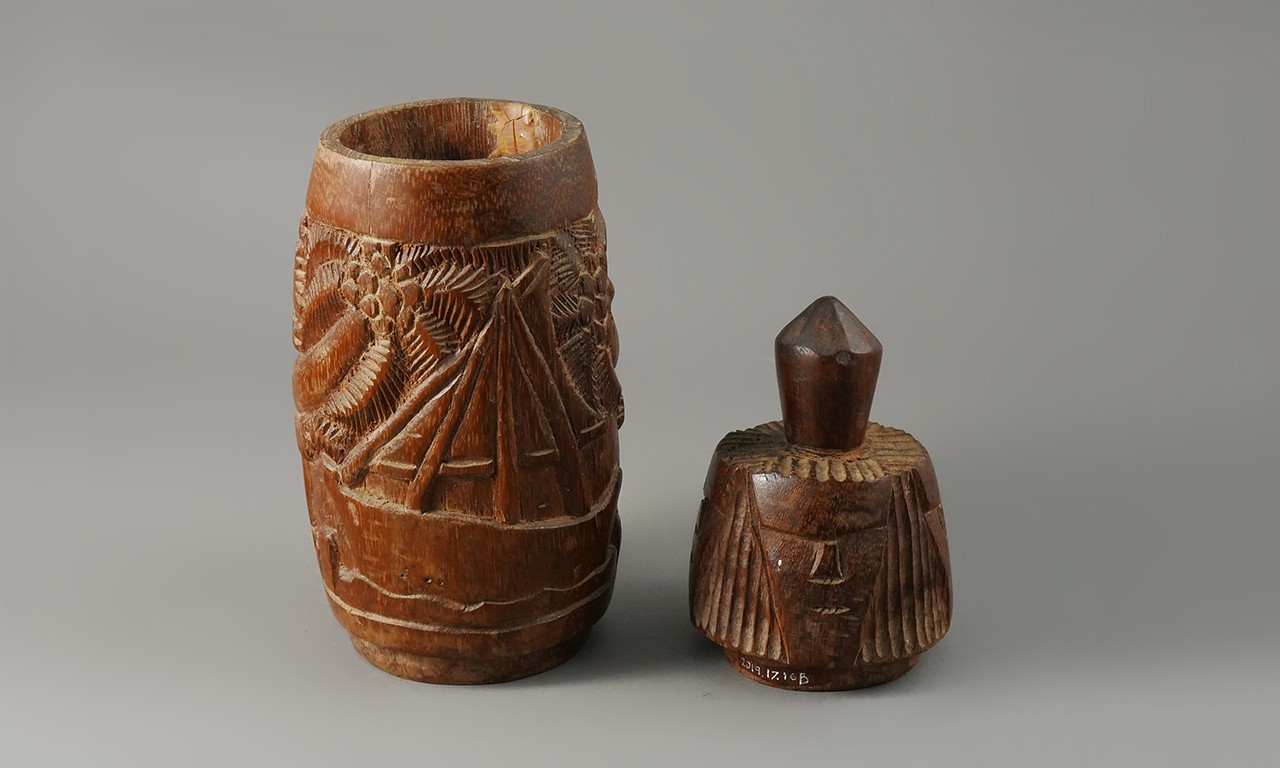 |
Money Pot, mid 20th Century
John Paul (Palauan); Koror Island, Palau, Micronesia
Wood; 8 1/4 × 3 1/4 in.
2019.17.16a,b
Gift of Frieda O. Wray from the Estate of Dr. & Mrs. Douglas and Carolyn Osborne |
Carved Collection
Prior to returning to Palau in 1968, Dr. Osborne published his most influential work, “The Archaeology of the Palau Islands: An Intensive Survey” (1966). This study provided detailed explanations of the Osborne’s archeological findings along with historical accounts and ethnographic research gathered from the island locals. As the Osbornes’ interest and dedication to the archeological study of the area grew, so did their desire to preserve and document the Palauan culture. During the course of their two trips, the Osbornes’ collected numerous pieces that encompassed the daily lives of Palauan locals. Such objects included two traditional money pots intricately carved by local Palauan carver John Paul in 1969. No longer used for the intended purpose of storing traditional Palauan bead currency—due to Palau having already transitioned over to the US dollar economy at the time—carvers continued to produce money pots for the intention of trade. The Bowers Museum is honored to preserve the Osborne legacy and share this one of a kind narrative.
Post researched and written by Jessica Arellano, Volunteer for the Bowers Museum Collections Department. Text and images may be under copyright. Please contact Collection Department for permission to use. References are available on request. Information subject to change upon further research.






Comments